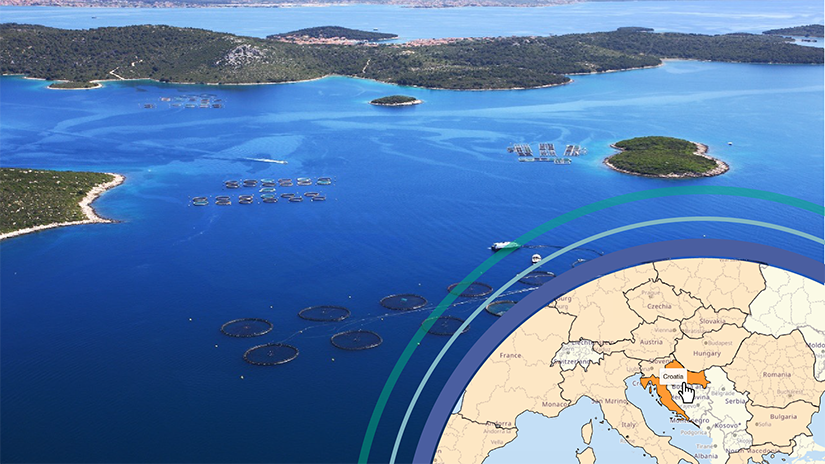Background information

Typ av arter som odlas
De viktigaste arterna är Gilthead fläckpagell (Sparus aurata), havsabborre (Dicentrarchus labrax), blåfenad tonfisk (Thunnus thynnus), karp (Cyprinus carpio) och andra växtätande karparter, öring (Oncorhynchus mykiss), Medelhavsmussla (Mytilus galloprovincialis) och europeiskt ostron (Ostrea edulis).
Källa: 2023, EUMOFA, 2022, STECF. Jordbruksministeriet – fiskeridirektoratet, MA-DoF
Typ av produktionsmetod
Under 2021 skedde mer än 85 % av Kroatiens produktion i marina vatten och resten i sötvatten. Följande huvudsakliga produktionsmetoder användes:
Sektorns storlek (produktion och konsumtion)
Källa: MA-DoF, 2023, EUMOFA
Trender (tidigare och framtida)
Hållbar utveckling av vattenbrukssektorn genom att förbättra vattenbrukets produktivitet på ett klimatsmart och hållbart sätt, med hjälp av ny digital teknik och nya digitala innovationer, stärka sektorns konkurrenskraft och vattenbrukssektorns bidrag till utvecklingen av landsbygds- och kustekonomier.
Källa: MNSPA-NPRA 2027
Vattenbrukets inverkan på landets ekonomi, livsmedelsmarknad och arbetsmarknad
De flesta vattenbruksanläggningar är mikroföretag, särskilt små familjeägda skaldjursodlingar, som trots sitt sociala värde inte bidrar i någon större utsträckning till den totala produktionsvolymen och det totala produktionsvärdet.
De medelstora och stora företagen inom det marina vattenbruket (tonfisk, havsabborre och fläckpagell) är dock i minoritet, men deltar i den totala produktionen med mer än 80 %, vilket är det viktigaste segmentet inom vattenbruksnäringen.
Inom sötvattenssektorn dominerar småskaliga företag med ett deltagande i den totala produktionen på cirka 15 %, men med stor betydelse för bevarandet och bevarandet av den biologiska mångfalden (de flesta karpdammar är Natura 2000-områden) och har potential att främja utveckling och sysselsättning i landets inlands- och landsbygdsområden.
Källa: Eurofish, MA-DoF
Utmaningar och möjligheter
- Diversifiering av arter och produkter, ytterligare teknisk utveckling av sektorn.
- Avsaknad av producentorganisationer.
- Behovet av att förbättra marknadsförings- och varumärkesverksamheten.
- Ytterligare förbättringar av tillämpningen av god praxis och protokoll för förvaltning av djurhälsa och djurskydd.
- Otillräcklig bearbetningskapacitet och produktion av produkter med högre mervärde, särskilt inom vissa segment av sektorn (vattenbruk i sötvatten och skaldjursodling).
- Instabila marknader och höga produktionskostnader (småskaliga skaldjursodlare).
- Öka produktiviteten,
- Stärka vattenbrukssektorns konkurrenskraft.
- Se på anpassningen till klimatförändringarna, genom att stärka hela vattenbrukssektorns motståndskraft, men också genom att begränsa klimatförändringarna genom användning av innovativ teknik som bidrar till visionen om en koldioxidsnål ekonomi.
- Vattenbrukssektorns bidrag till att återställa landsbygds- och kustekonomierna och förbättra levnadsvillkoren i landsbygds- och kustområden.
- Främja innovation inom vattenbrukssektorn.
Källa: MNSPA-NPRA 2027
Sysselsättning och antal företag
177 företag 2023
Källa: MA-DoF
Multi-annual National Strategic Plans for the development of sustainable Aquaculture
Beslut av RC:s regering om godkännande av NPRA 2027 (på kroatiska): webbplats: https://narodne-novine.nn.hr/clanci/sluzbeni/2022_11_133_1998.html
Relevant Authorities
Applicable Legislation
- Vattenbrukslagen: Nr 130/2017, nr 11/2018, nr 144/2020 och nr 30/2023
- Förordning om registret över licenser för användning av främmande och lokalt frånvarande arter i vattenbruk, registret över import och överföringar och förteckningen över slutna vattenbruksanläggningar nr 10/2018
- Förordning om vattenbrukstillstånd nr 17/2018
- Förordning om yrkesutbildning för vattenbruksverksamhet nr 56/2018
- Förordning om kriterier för inrättande av vattenbruksområden på havsområdet nr 106/2018
- Förordning om insamling av statistiska uppgifter om vattenbruk: Nr 137/2021 och nr 87/2022
- Förordning om godkännande för bedrivande av vattenbruksverksamhet på familjejordbruk
- Förordning om avsättning av odlingskapacitet för tonfisk och tillåtna mängder fångad vild tonfisk (Thunnus thynnus) till odlingsanläggningar: Nr 22/2021, nr 9/2022, nr 8/2023 och nr 9/2024
- Förordning om märkning av odlingsanläggningar, övervakning av odlingsanläggningar och spårbarhet vid odling av blåfenad tonfisk (Thunnus thynnus) nr 63/2022
- Förordning om register över vattenbruksfartyg No.61/2023
Applicable Procedures
Other Relevant Documents
National associations and networks
- Kroatiska ekonomikammaren, jordbrukssektorn, fiskeriföreningen
- Kroatiska handels- och hantverkskammaren, Fiskeri- och vattenbrukskammaren
- Kluster för vattenbruk
- Lantbrukarförbundet för stonskaldjur
Contact Details
Jordbruksministeriet – fiskeridirektoratet
Tatjana Boroša Pecigoš, chef för tjänsten för vattenbruk
- Mejla oss
- Telefonnummer: + 385 1 6443 190
